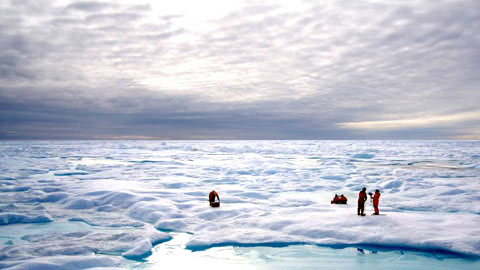Arctic was practically ice-free 4 million years ago

28/11/2014
Researchers from the UAB, the University of Tromsø, Norway, and Plymouth University, UK, have studied the tendency of extension of Arctic ice between 5.3 and 2.6 million years ago. That period was the last in which the Earth experienced a long time with an averagely warm climate before the ice ages began to alternate with soft interglacial periods such as the one existing now. Researchers have discovered that, at its height, the Arctic ice cap did not occupy the extension it currently does until only 2.6 million years ago. The Arctic ice cap had a much smaller extension some four to five million years ago.
“The objective of the research is to understand the state of our planet in the conditions of global warming foreseen for the end of the 21st century, and that is why we are studying the Earth's climate during the Pliocene Epoch, a geological period extending from 5 to 2.5 million years ago" explains UAB professor Antoni Rosell, co-author of the research and researcher at the Catalan Institution for Research and Advanced Studies, ICREA.
“When studying the fossil molecules of microscopic marine organisms found in the sediments of the ocean floor, we discovered that a good part of the Arctic ocean did not have ice four million years ago”, highlights Jochen Knies, lead author of the study and researcher at NGU and the Centre of Excellence CAGE (Centre for Arctic Gas Hydrate, Environment and Climate of the University of Tromsø, Arctic University of Norway).
The evolution of the extension of ice in the Arctic has always been uncertain. This research for the first time shows how the ice in the Arctic Ocean was formed before other continental ice masses appeared in the northern hemisphere. The information is of great interest given that current global warming conditions are melting the Arctic Ocean's ice cap. The results can be used as a climate modelling tool to show the type of climate there will be at the end of the 21st century and to improve current climate prediction models, which foresee that the Arctic Ocean will be completely ice-free at the end of this century.
For researchers, there is no doubt that this study will be one of the working tools used to prepare future reports for the UN's Intergovernmental Panel on Climate Change (IPCC).
The research was based on data taken from the sediments of a well dug at the bottom at the sea and located to the northeast of Spitsbergen, the largest island of the Svalbard archipelago. The well was dug thanks to the International Ocean Drilling Programme which has spent decades studying the sediments at the bottom of the ocean for scientific purposes. With the chemical analysis of the fossil remains of microscopic algae living in the ice, and of microorganisms found in the water, researchers were able to trace back the variations in environmental conditions and discover with all precision the moment in which the ice reached that specific area of the ocean.
Researchers believe that the growth in the ice cap until 2.6 million years ago was in part due to the changes in ocean currents and the rise of large continental masses occurring during that period. The changes in altitudes in many parts of the Arctic, including Svalbard and Greenland, and the accumulation of ice caused the ice cap to distribute itself across the surface of the ocean as well. Moreover, the Bering Strait opened between America and Russia and the Panama Canal closed in Central America, making a large amount of cold water reach the Arctic and facilitating the formation of more ice in the Arctic Ocean.
The research, published in Nature Communications, is the result of an international collaboration between the NGU, the University of Tromsø (Arctic University of Norway), Plymouth University and the Universitat Autònoma de Barcelona.